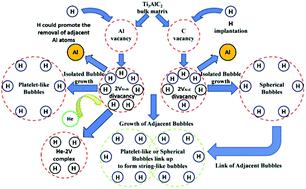当前位置:
X-MOL 学术
›
Phys. Chem. Chem. Phys.
›
论文详情
Our official English website, www.x-mol.net, welcomes your feedback! (Note: you will need to create a separate account there.)
New insight into the interaction between divacancy and H/He impurity in Ti3AlC2 using first-principles studies.
Physical Chemistry Chemical Physics ( IF 3.3 ) Pub Date : 2020-08-05 , DOI: 10.1039/d0cp02982c Zhaocang Meng 1 , Canglong Wang 2 , Jitao Liu 2 , Yinlong Wang 3 , Xiaolu Zhu 4 , Lei Yang 2 , Liang Huang 5
Physical Chemistry Chemical Physics ( IF 3.3 ) Pub Date : 2020-08-05 , DOI: 10.1039/d0cp02982c Zhaocang Meng 1 , Canglong Wang 2 , Jitao Liu 2 , Yinlong Wang 3 , Xiaolu Zhu 4 , Lei Yang 2 , Liang Huang 5
Affiliation

|
First-principles calculations have been conducted to investigate the interaction between vacancy defects and H/He impurity in Ti3AlC2. The formation energies of monovacancy and divacancy have been calculated. It is found that Al monovacancy (VAl), Al divacancy (2VAl–Al), and the divacancy composed of Al and C atoms (2VAl–C) are most easily formed in all vacancies. In addition, the interactions between multiple vacancies are weak. The formation of vacancy is relatively independent and not affected by other vacancies. The configurations and energies of H–mV (m = 0, 1, 2) complexes have been studied to assess the energetically favorable sites for H atoms. Within pre-existing VAl or 2VAl–Al, the most favorable site for H atoms is the Itetr-2 site, but the H atom tends to occupy the Ioct-4 site within 2VAl–C. The formation energies of the secondary vacancy defect nearest to an Al vacancy or C vacancy are significantly influenced by H impurity content. H clusters trapped in a primary Al vacancy can promote the formation of vacancy and prefer to form platelet-like bubbles parallel to the Al plane, while H clusters trapped in a primary C vacancy have higher probability to form spherical ones. The 2VAl–Al and 2VAl–C divacancies exhibit stronger H trapping ability than monovacancy. The 2VAl–Al divacancy could capture up to seven H atoms, and 2VAl–C could capture six H atoms. Meanwhile, the He–2VAl–Al complex could only capture four H atoms to form H–He hybridized bubbles, and He impurities effectively suppress further aggregation of H atoms. The present results provide microstructural images of nH–mV and nH–He–mV complexes as well as the evolution progress of H bubbles in Ti3AlC2, which is especially helpful for us to understand the behavior of H/He in Ti3AlC2 under irradiation.
中文翻译:

使用第一性原理研究洞察力与Ti3AlC2中H / He杂质之间相互作用的新见解。
已经进行了第一性原理计算,以研究Ti 3 AlC 2中空位缺陷和H / He杂质之间的相互作用。计算了单空位和双空位的形成能。发现在所有空位中最容易形成Al单空位(V Al),Al空位(2V Al–Al)以及由Al和C原子组成的空位(2V Al–C)。另外,多个空缺之间的相互作用很弱。空缺的形成是相对独立的,不受其他空缺的影响。H– m V(m= 0、1、2)配合物已被研究过,以评估H原子在能量上的有利位置。在预先存在的V Al或2V Al–Al中,对H原子最有利的位点是I tetr -2位,但H原子倾向于占据2V Al–C内的I oct -4位。H杂质含量显着影响最接近Al空位或C空位的二次空位缺陷的形成能。最初的Al空位中捕获的H团簇可以促进空位的形成,并且倾向于形成与Al平面平行的血小板状气泡,而最初的C空位中捕获的H团簇形成球形的可能性更高。2V Al–Al和2V Al–C空位比单空位表现出更强的H捕获能力。2V Al–Al的空位可以捕获多达七个H原子,而2V Al–C可以捕获六个H原子。同时,He–2V Al–Al络合物只能捕获四个H原子以形成H–He杂化气泡,而He杂质有效地抑制了H原子的进一步聚集。目前的结果提供了n H– m V和n H–He– m V配合物的微观结构图像,以及Ti 3 AlC 2中H气泡的演化过程,这对我们了解H / He的行为特别有帮助。在Ti 3 AlC 2中 在辐射下。
更新日期:2020-08-25
中文翻译:

使用第一性原理研究洞察力与Ti3AlC2中H / He杂质之间相互作用的新见解。
已经进行了第一性原理计算,以研究Ti 3 AlC 2中空位缺陷和H / He杂质之间的相互作用。计算了单空位和双空位的形成能。发现在所有空位中最容易形成Al单空位(V Al),Al空位(2V Al–Al)以及由Al和C原子组成的空位(2V Al–C)。另外,多个空缺之间的相互作用很弱。空缺的形成是相对独立的,不受其他空缺的影响。H– m V(m= 0、1、2)配合物已被研究过,以评估H原子在能量上的有利位置。在预先存在的V Al或2V Al–Al中,对H原子最有利的位点是I tetr -2位,但H原子倾向于占据2V Al–C内的I oct -4位。H杂质含量显着影响最接近Al空位或C空位的二次空位缺陷的形成能。最初的Al空位中捕获的H团簇可以促进空位的形成,并且倾向于形成与Al平面平行的血小板状气泡,而最初的C空位中捕获的H团簇形成球形的可能性更高。2V Al–Al和2V Al–C空位比单空位表现出更强的H捕获能力。2V Al–Al的空位可以捕获多达七个H原子,而2V Al–C可以捕获六个H原子。同时,He–2V Al–Al络合物只能捕获四个H原子以形成H–He杂化气泡,而He杂质有效地抑制了H原子的进一步聚集。目前的结果提供了n H– m V和n H–He– m V配合物的微观结构图像,以及Ti 3 AlC 2中H气泡的演化过程,这对我们了解H / He的行为特别有帮助。在Ti 3 AlC 2中 在辐射下。


























 京公网安备 11010802027423号
京公网安备 11010802027423号